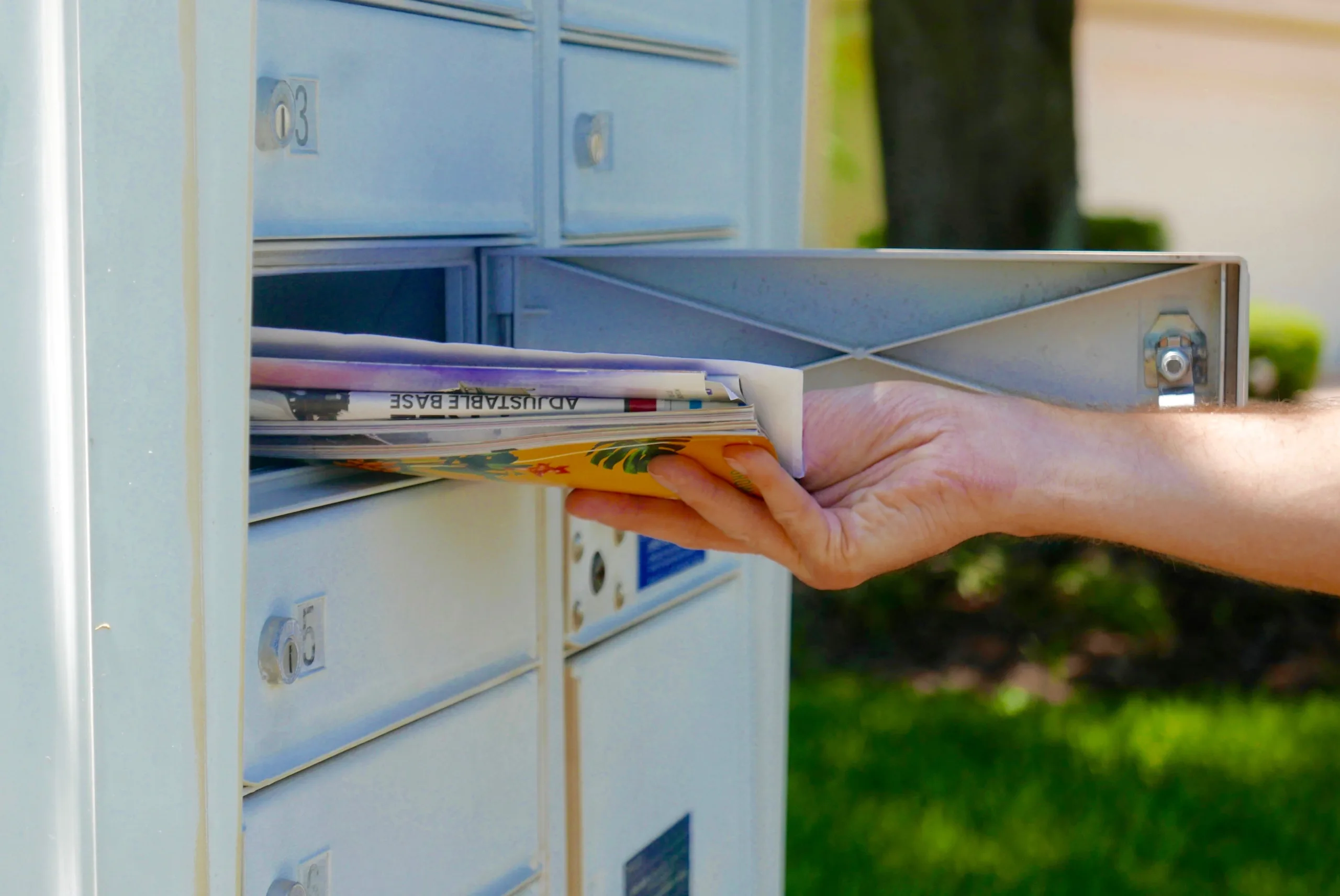What is Direct Mail Marketing?: An Ultimate Guide
- Branding
- Content Marketing
- Creative Campaigns
- Marketing Strategy

Have you ever used direct mail marketing for your business? In the digital age, many marketers avoid direct mail because they think it’s old-fashioned and can’t compete with other channels. Other companies have used direct mail before, but weren’t happy with their ROI because their campaign wasn’t well executed.
If you’ve ever asked “what is direct mail marketing?” or want to learn more about this time-tested marketing channel, we’re here to help. This ultimate guide provides the basics you need to understand direct mail marketing. We’ve also sprinkled in tips and advice that will help you execute your next campaign like a pro.
What Is Direct Mail Marketing?
Before we can get into the details, it’s important to define direct mail and direct mail marketing. Let’s start by answering a common question :: what is direct mail?
Direct mail is print marketing that’s sent out in the mail (usually via the USPS). It can come in a variety of formats, such as postcards, brochures, and parcels. Direct mail can contain coupons and offers, or it can be purely informational with a soft call to action (CTA). Direct mail is sent to a predefined group of people on a mailing list or carrier route (a smaller segment of a ZIP Code).
Direct mail marketing is a form of direct marketing that targets people with direct mail pieces sent in the mail. Like any marketing channel, it has its own set of best practices. We’ll take a closer look at two of them below.
Direct Mail Best Practice :: The 40 / 40 / 20 Rule
When it comes to direct marketing, the 40 / 40 / 20 Rule is one of the oldest plays in the book. This guideline was developed in the 1960s by marketing pioneer Ed Mayer. Basically, the 40 / 40 / 20 Rule provides advice on how marketers should break down their direct marketing efforts.
While the 40 / 40 / 20 Rule was created in the pre-Internet age, it’s still relevant today — especially for direct mail marketing. The 40 / 40 / 20 Rule breaks successful direct marketing down into three main elements :: audience, offer, and everything else.
- Audience. You should focus 40% of your attention on choosing the right audience for your direct mail piece. Even if your mail piece is perfectly designed, your efforts will be wasted if you send it to people who aren’t interested or can’t use your offer.
- Offer. Mayer recommends putting 40% of your energy into creating a relevant offer. Providing recipients with an appealing offer they can actually use encourages them to take action. Including a CTA with your offer is very helpful because your audience knows their next steps.
- Everything else. Dedicate the final 20% of your time and energy to the details. This includes elements like direct mail format, design, and copy.
Direct Mail Best Practice :: Reach vs. Frequency
Balancing reach with frequency is also critical to any direct mail marketing strategy. Here’s what we mean by reach and frequency:
- Reach is the number of people you send your direct mail piece to. In other words, it’s the number of people on your mailing list or carrier route. If you mail to 2,500 people, your reach for that campaign is 2,500.
- Frequency is the number of times you send your direct mail piece to the same person. If the same person sees your ad two times, the frequency for that campaign is two.
It’s easy to fall into the trap of thinking reach is more important than frequency. You want to get in front of as many people as possible, right? Not necessarily! According to the Rule of Seven, people must see your brand at least seven times before they notice it and take action. That’s a lot of impressions!
With this in mind, you should always prioritize frequency over reach when sending direct mail. Mail to a smaller group of people several times, instead of a large group of people one time. Like any marketing channel, consistency is key to your success because it helps you stay top of mind.
Can Direct Mail Marketing Work for My Business?

Yes! Direct mail works for businesses and organizations in every industry you can think of. Here’s a short list of businesses and organizations that can benefit from direct mail:
- Restaurants
- Gyms
- Grocery Stores
- Churches
- HVAC Companies
- Landscaping Companies
- Accounting / Tax Firms
- Automotive Shops
- Dentists
- Salons
Whether you’re looking to boost sales, increase brand awareness, or reactivate lapsed customers, direct mail can do it all.
Not convinced yet? Just check out these direct mail response rates from the Compu-Mail. The response rate to direct mail can be as high as 37%. Direct mail also pairs well with digital marketing. And Merkle reports that campaigns using both direct mail and digital marketing saw a 118% lift in response rates, as opposed to campaigns that only use one advertising channel.
Who Should I Send My Direct Mail To?
Figuring out who to target with your direct mail is the first step of any successful campaign. Who you mail to varies based on the goals of your direct mail campaign, which we’ll discuss later. First, let’s look at three common methods marketers use to segment their direct mail audience.
Ways to Segment Your Direct Mail Audience
There are a variety of ways to segment your audience into groups with shared characteristics. Here are three of the most common:
- Geographic segmentation. This method is exactly what it sounds like and involves targeting people within a specific geographic area. This might be people who live within a specific ZIP Code, carrier route, or radius of your business.
- Demographic segmentation. This method breaks people down into groups that share specific personal characteristics. These can include gender, race, income, education, and employment.
- Firmographic segmentation. This method is used in business-to-business (B2B) marketing. It breaks companies into groups based on traits like industry, location, customer type, legal status, and performance.
Putting Audience Segmentation Into Action
So, what does audience segmentation look like when it comes to direct mail marketing? Here are a few examples:
- New mover campaigns. These help you drum up business with people who are new to your area. You can purchase a mailing list of new movers and get to them before the competition.
- Grand opening campaigns. Opening a new location? Use geographic segmentation to target people who live within a certain area of your new location.
- Abandoned cart campaigns. Use your eCommerce platform to identify people who have abandoned their online shopping cart. Mailing them a special offer for the product / service they were interested in can get them to complete their transaction. Abandoned cart remarketing is commonly done via email, but direct mail is also a great option because most companies don’t use it for this purpose.
- Birthday campaigns. Obtain a list of prospects with birthdays or mail to your existing customer database during their birthday month. Making this personal connection can encourage them to take action on your CTA.
- Rewards club / loyalty program campaigns. Show appreciation for members of your rewards club or loyalty program by sending them special offers. This is a great way to upsell, since they’re already brand advocates.
- Upsell campaigns. Send existing customers an offer for an item that complements something they recently bought from you. For example, if someone purchases bait from your sporting goods store, send them an offer for a fishing rod. Even if they aren’t in the market for a rod at the moment, they’ll be reminded of your brand and may purchase from you again in the future.
- Winback campaigns. Since you already have data on lapsed customers, it’s easy and inexpensive to create a personalized offer they’re likely to respond to.
What Are Direct Mail Formats?
So, you know who to mail to and the campaign type that’s best for you. But which direct mail format should you choose? This is a very important decision, and the format you choose can have a big influence on whether your campaign is successful. Here are a handful of the most common direct mail formats.
Brochures / Menus
Brochures have more space than some other direct mail formats, so they’re perfect for sharing detailed information about your products / services. If you run a foodservice business, your brochure might take the form of a menu. Menus help boost brand exposure because recipients may put them on the fridge or in a kitchen drawer.
Letters
Because they’re sealed in an envelope, letters can feel more confidential than other formats. They also offer a lot of personalization options. They’re great for things like prospecting and upselling to existing customers.
Postcards
Postcards work well for prospecting because they’re an inexpensive way to get in front of people who may not be familiar with your business yet. Make a great introductory offer, and you may just get them through your doors. You can also send postcards to existing customer lists, like people with birthdays or members of your loyalty program.
Direct mail postcards have evolved far beyond the traditional 4” x 6” postcard. Today, companies can send interactive postcards that play video content or have scratch-away stickers with special offers printed underneath.
Periodicals
According to the USPS, periodicals are newspapers, magazines, and other publications sent to a list of opt-in subscribers. Businesses use periodicals to stay top-of-mind with existing customers, boost brand awareness among prospects, and provide information on their products or services.

Packages
Businesses that sell expensive products / services might send parcels (like gift boxes) to high-value customers / prospects. This usually costs more than sending other direct mail formats, but it can pay off if customers make repeat purchases or if your product / service has a high price point.
Which Direct Mail Mailing List is Right for Me?
Once you know who you’re mailing to, you’re ready to get your direct mailing list. Like we said before, your target audience plays a key role in the mailing list you choose. Let’s take a look at two common mailing list types and the USPS Every Door Direct Mail® (EDDM®) service.
Targeted Mailing Lists
Like the name suggests, these mailing lists target specific people based on shared traits. Say your business designs and manufactures high-end navigational systems for yachts. You wouldn’t mail to just anybody, right? Instead, you’d get a targeted mailing list comprised of yacht owners or people who have expressed interest in nautical navigation systems in the past.
As you can see, targeting a specific group of people with shared traits helps you reach individuals who might be more receptive to your offer. Knowing their names and a few personal traits also helps make your direct mail more personal, which can increase response rates by up to 36%.
Targeted mailing lists can be expensive depending on how specific they are. A house customer list is another example of a targeted mailing list, but it’s free since you already own the names on the list.
Saturation Mailing Lists
Saturation mailing lists contain the names of people who live within a certain geographic area. As a result, they help you blanket specific areas with your direct mail campaigns. Saturation lists work best for businesses that offer a product or service almost anybody could use, like restaurants and auto shops.
Because they’re less specific, saturation mailing lists usually cost less than targeted lists. However, you can still do some targeting when you use a saturation list. You can remove the following address types from a saturation list:
- Business addresses
- PO Boxes
- Some residential addresses (i.e. apartments, seasonal dwellings, drop addresses)
If you do choose to remove address types from your list, make sure you still adhere to the 90 / 75 Rule to get the best postage rates. This stipulates that you must mail to 90% of all residential addresses or 75% of all business and residential addresses on your chosen carrier route
Every Door Direct Mail® (EDDM®) (No Mailing List)
EDDM® is a DIY USPS direct mail service. Unlike campaigns that use targeted or saturation mailing lists, EDDM® does not require a mailing list. That’s because your direct mail is delivered to nearly every address / door along a carrier route.
You can still do some audience segmentation with EDDM®, even though there’s no mailing list. The USPS EDDM® tool allows you to segment by the following median demographics:
- Address types (residential or business)
- Age
- Household size
- Household income
Keep in mind that because EDDM® uses median figures, your pieces will reach people who may not be interested in your offer. Direct mail sent via EDDM® is addressed to “Local Postal Customer” since there’s no mailing list. You’re also restricted when it comes to the size and format of your pieces. You can only send flats, which are large envelopes, newsletters, and magazines.
How Do I Get a Direct Mail Mailing List?
You’ve chosen the type of mailing list you want to use. But where do you get a direct mail mailing list? There are several mailing list sources, which we’ll review below.
Use Your House List

Don’t overlook your house list of existing customers or people who have expressed interest in your business in the past! This free option can be very effective because you already have information on these individuals. Here are a few examples of house lists:
- Active customers
- Past customers
- Prospects who provided you with their contact information
- Members of your rewards club or loyalty program
- One-time customers
You own your house list, so make sure you keep it clean and updated. Here are three mailing list data hygiene best practices:
- Make sure your mailing list is CASS (Coding Accuracy Support System) certified. CASS standardizes your addresses for the USPS to ensure deliverability. This process includes things like adding ZIP + 4 codes and IMBs (Intelligent Mail Barcodes) to your mail pieces.
- Run your mailing list through the NCOA (National Change of Address) database. This service provides up-to-date information on people who have moved within the last four years. That way, you don’t waste money mailing to people who no longer live at an address.
- Deduplication allows you to pinpoint and merge duplicate records, which saves you money because you’re not mailing to the same people twice.
If you don’t want to use a house list (or if you don’t have one yet), you can also rent or buy a mailing list.
Rent or Buy a Mailing List
If you only plan on mailing to a group of people one or two times, renting a mailing list is a smart option. While you don’t own the names on the mailing list, you do own any information you get from the people you mail to. You don’t have to maintain the list yourself, and rented lists typically cost less than purchased lists.
If you plan on using a list many times, buying a mailing list is usually your best bet. You’ll own the names on the mailing list and any information you gather from recipients. You’ll need to perform your own list hygiene, though.
There are two main types of rented or purchased mailing lists: compiled lists and response lists.
- Compiled lists contain the names of people with similar interests, like rock climbing, tennis, or gardening.
- Response lists contain the names of people who have purchased from or requested information from businesses offering products / services that are similar to yours.
How Do I Track My Direct Mail Campaigns?
Direct mail tracking is very important, but many marketers overlook it. Don’t make this mistake! When choosing a tracking method, make sure you consider the format of your piece and the goals of your campaign. Make sure you’re using different tracking codes for each direct mail campaign so you can differentiate between them.
Here’s a short list of methods you can use to track your campaign:
- Trackable phone numbers. Adding a trackable phone number to your piece allows you to determine how many calls you receive as a result of your direct mail. This helps you tweak future campaigns because you’ll know what is and isn’t working.
- Trackable URLs or PURLs (personalized URLs). These are another easy way to track the effectiveness of your campaign. Adding a name to a URL (i.e. https://www.towermarketing.net/norafulmer) and greeting them by name on the landing page helps you speak to people on a one-to-one level.
- Trackable email addresses. Like trackable phone numbers and URLs, printing trackable email addresses on your pieces helps you track response rates for your campaign. Use it to look for trends that you can use for future audience segmentation and tracking.
- Coupon codes. If your direct mail piece includes coupons, make sure each coupon has its own unique code. Whether recipients redeem the coupon in person, over the phone, or online, make sure employees are meticulously tracking coupon codes. This helps you determine which offers are getting results and which ones aren’t.
- QR codes. QR codes are easily trackable and help you glean valuable information on your direct mail campaigns. Plus, they’re easier for prospects / customers to follow up on, since they don’t have to type a URL / PURL into their web browser. All they have to do is scan your QR code with their smartphone camera or a QR code reader app.
How Much Does Direct Mail Cost?
This is one of the most frequently asked questions when it comes to direct mail marketing. However, there’s no one-size-fits-all answer. As you’ve learned, there are a wide variety of components involved in any direct mail campaign. Everything from your mailing list type to the format you use affects your cost. That’s why working with an agency that offers direct mail marketing services (like Tower!) is a great way to lower your expenses. We use our experience and connections with vendors to get you the best results at the lowest price point.
Want to try a direct mail campaign for your business? Contact our print media experts today to start the conversation!
 Grace H
Grace H  Kelly H
Kelly H